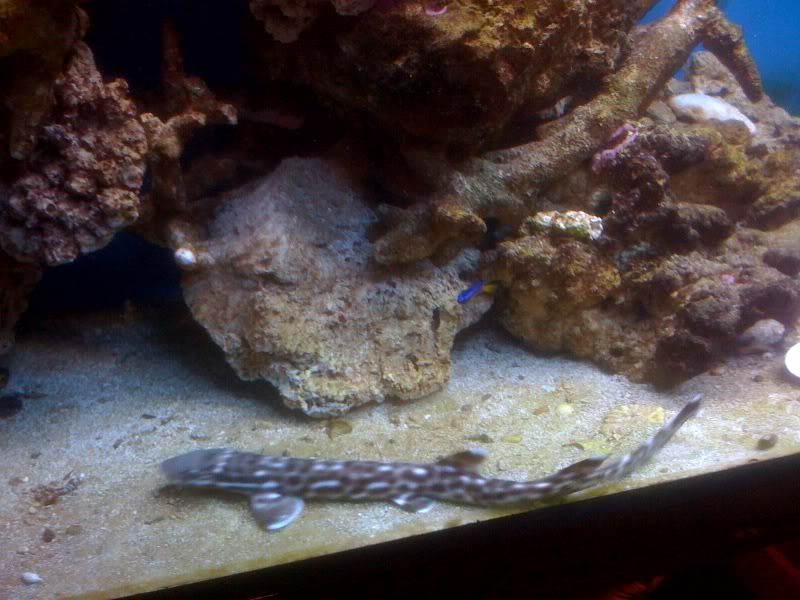Here's a list of sharks that may be seen in LFS or Online dealers that should generally be considered to be Unsuited for Private Aquarists. Although naturally there may be a few Private aquarists with systems large enough to handle even these species.Family - Triakidae (Smoothhounds) - presently there's just one species that is generally unsuited for most private aquarists -and that is the Leopard Shark.
- The Leopard Shark (Triakis semifasciata) - which can grow to be 6ft(about 1.8 meters). Also the tend to prefer cooler waters usually below 72F (22 C). As an adult, they require a tank/pond of at least 350 sq.ft . with over 10,000 gallons. Also because of the Lacey Act - it's illegal to catch or sell Leopards under 36" in length.
Family - Ginglymostomidae (Nurse Sharks) - actually represented by 3 species. Generally the members of this family adapt to captivity fairly easily (even to the point of breeding in captivity) and tend to be very hardy species. Only the the Common or Atlantic Nurse is generally available in LFS or online dealers.
-Common Nurse Shark (Ginglymostoma cirratum) -while often quoted at reaching up to 14 ft (4.3 meters), - this is presently unconfirmed. And is either an overexaggeration of the species actual maximum size (which is confirmed at 11-12ft), or confusion with the closely related, but slightly larger Tawny Nurse (Nebrius ferrugineus). While Nurses can possible be kept in large home aquaria(about 500 gallons) for a few years(usually 2-3 at most). The problem with this species - is very few aquarists are capable of handling an average sized adult (about 8-10 ft,200-300 lbs) for it's entire life(which may exceed 30 years). A single average size adult requires a tank/lagoon of at least 700 sq.ft, and a volume of 20,000 gallons or more to keep it in.
Family - Carcharhinidae (Requiem Sharks) - virtually all members of this family are either suited only for public aquariums or the ocean. Since all member that are available require lots of swimming room, and most members of this family tend to be Obligated Ram Ventilators(they must swim to breath). Still there are few species that is fairly regularly seen in LFS & thru various online dealers.
-The Blacktip Reef (Carcharhinus melanopterus) is the most popular, and can grow to 6 ft (about 1.8 meters). Still often sold as pups (about 15-20" long) - this species is very active and requires lots of space. Pups need tanks/ponds of at least a 5-6,000 gallons just to reach maturity(at about 3-3.5' long). As an adult - they require a tank/pond with at least the following -no sharp corners, at least 5' deep, at least 650 sq.ft footprint, and a volume over 24,000 gallons.
- The Atlantic Sharpnose (Rhizoprionodon terraenovae) is a small atlantic coastal species, which grows to about 4' (1.2 meters) in length. Still the species is very high strung, incredible active, and usually requires to be kept in small groups(of 3-5) to be successful. Becuase to this -this species requires similar to that needed for the Blacktip Reef - basically of a round or oval design, that at least 650 sq.ft. and over 3.6 ft (1.1 meters) deep - with a volume of at least 18,000 gallons - and virtually no rock or coral decor.
- The Bonnethead (Sphyrna tiburo) is the smallest member of the hammerhead family. They can grow up to 5' (about 1.5 meters) in length, although they rarely exceed 4' (about 1.2 meters) in length. While Bonnets don't need to be kept in groups - the do need tanks/ponds of a round or oval design, and virtually no rock or coral decor. Still a single adult requires a pond/tank that is at least 4' deep, has 500 sq.ft (or more), and over 15,000 gallons.
/>- The Whitetip Reef (Triaenodon obesus) - don't have to swimming in order to breath. But still require alot of room. While the species tend to be fairly hardy, and is able to adapt to captivity. It's best suited to public aquariums - with experienced Marine biologists that are best able to understand it's tempermental nature. The species is capable of reaching 7' (about 2.1 meters) in length. And because it's size it needs a tank/pond that is at least 650 sq.ft, 6' deep, and a volume of over 29,000 gallons.
- The Lemon (Negaprion brevirostris) - also aren't ORVs, but are the largest requiem shark that is available to private aquarists. And potentially the most dangerous. Lemons are known to be very aggressive and tempermental as adults. They can grow to more than 11ft (3.35 meters) in length - although usually average about 9' (2.75 meters). Still because of the active nature, & size - they require a tank/pond the size of a small public aquarium - with at least 1,500 sq.ft. and a volume over 65,000 gallons.
Just a few thoughts - to help everyone see - just how Unsuitable - these unsuitable species really are.



